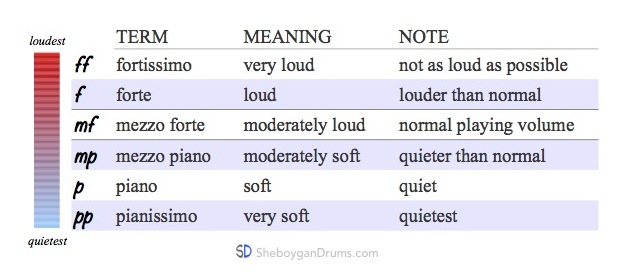Dynamics and Dynamic Markings
Understanding Dynamics
dy•nam•ics |dīˈnamiks| The levels of volume in music.
What are Dynamics?
Dynamics are the levels of volume in music, an important aspect of music. Drums are especially good at playing dynamics. Since drums are inherently loud, it reveals skill when a drummer plays quietly. Nonetheless, it is often the loud parts that are the most exciting. Playing a contrast between soft and loud can make music more interesting.
As a drum teacher, I’ve found useful ways to help drummers understand dynamics. Introducing drummers to dynamics adds a level of complexity to drum music which can be overwhelming at first. It requires paying attention to additional musical symbols. Dynamic markings are the symbols used to specify volumes in musical notation.
Dynamics can add difficulty to playing drum parts. For example, drummers will find it more difficult to play certain rhythms quietly than to play the rhythms at a normal volume. Likewise, playing loudly can pose challenges for some rhythms.
Basic Dynamics
This chart shows the six most common dynamic markings. Consider mf your normal playing volume.

Why Do Dynamics Have Strange Names?
Like most musical notation conventions in USA, we inherited the terminology used for dynamics from classical music notation. Dynamic markings are abbreviations of the Italian words describing the volume. For more information about musical terms, see Italian musical terms – Wikipedia.
How Loud are Dynamics?
Dynamics are relative and do not refer to specific volumes. As with the basic dynamics, above, the goal is to create an audible distinction between each of the dynamic levels. When playing a solo, a musician will determine their loudest and softest volumes, and liberty can be taken to perform dramatic changes in volume. When playing with an ensemble, care must be taken to play a suitable volume.
How Loud is Loud?
Musicians can generalize about the volumes of specific dynamics, but what really matters, is volume relative to other volumes and other instruments. Dynamic changes must be noticeable.
Some music calls for a single dynamic. In such a piece, the drum volume is determined by the musical context and performance space. If the drum music is a solo, the drummer can use their discretion to identify the appropriate volume.
How Do Drums Play Dynamics?
Usually the harder a percussion instrument is struck, the louder sound it will make. This is often achieved by raising the drumstick higher before striking. Since it takes more time to raise the drumstick higher, anticipating the louder stroke is necessary to avoid playing late. Most drummers find the execution of dynamics intuitive, but the techniques involved in performing dynamics can require some practice.
More About Dynamics
See more about dynamics and dynamic markings – Wikipedia.
Like Sheboygan Drums on Facebook
